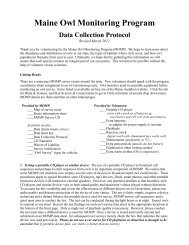Focus Species Forestry - Maine Audubon
Focus Species Forestry - Maine Audubon
Focus Species Forestry - Maine Audubon
Create successful ePaper yourself
Turn your PDF publications into a flip-book with our unique Google optimized e-Paper software.
Table 2. Stand Development Stages<br />
Stand Development<br />
Identification<br />
Stage Typical characteristics 1 Description<br />
Early<br />
Successional<br />
Intermediate<br />
Mature<br />
Late-Successional<br />
Regeneration<br />
and<br />
Seedlings<br />
Saplings and<br />
Small Poles<br />
Old-Growth<br />
Less than 30 sq.ft. basal<br />
area/ac. (BA) in trees >1 in.<br />
dbh.<br />
Typically 0-10 years<br />
BA in trees 1-5 in. dbh greater<br />
than that of trees 5 in.<br />
Typically 10-30 years old<br />
Majority of stocking in:<br />
• Softwood stands: >5 in.<br />
• Hardwood stands >5 in.<br />
Majority of stocking typically<br />
in trees 30-70 years old<br />
Majority of stocking in<br />
• Spruce-fir >9 in.<br />
• Hardwoods >12 in.<br />
• Pine-hemlock >12 in.<br />
Overstory typically 70-100+<br />
years depending on forest<br />
type<br />
Majority of stocking (better<br />
site quality, will vary with<br />
species, site, and stand<br />
history):<br />
• Spruce-fir ≥12 in.<br />
• Hardwoods ≥16 in.<br />
• Pine-hemlock ≥20 in.<br />
• Large deadwood<br />
accumulating<br />
• Indicator species (e.g.,<br />
certain lichens) present<br />
Transition from mature to late<br />
successional is generally in<br />
the 100-125-year age range<br />
Generally >150 years old<br />
Regeneration phase; may include partial<br />
residual overstory<br />
Young, closed-canopy stands or twostoried<br />
stands dominated by small trees<br />
with a partial residual overstory<br />
Includes even-aged stem-exclusion<br />
stands (little or no understory) and twostory<br />
stands with partial overstory of<br />
mature trees<br />
Includes stands dominated by small- to<br />
large-sized sawtimber, including stands in<br />
the late stem exclusion stage and early<br />
phases of understory reinitiation. May be<br />
single story, two story, or multi story<br />
depending on past harvest history.<br />
Depending on species and condition, may<br />
be maintained by individual tree or groupselection<br />
harvests.<br />
Net growth stable or declining in<br />
unharvested stands; principle mortality in<br />
canopy due to disease, wind, and insects.<br />
Large-diameter dead wood accumulating<br />
in standing trees and on the ground.<br />
Typically one or more age classes<br />
represented in the understory or in gaps<br />
but may be virtually even-aged in the<br />
case of pine and hemlock. When longlived<br />
species with medium to high shade<br />
tolerance are present, this stage can be<br />
maintained over time by light individualtree<br />
or group-selection management.<br />
Stands meeting diameter guidelines but<br />
lacking other characteristics should be<br />
classified at mature.<br />
Old growth is the culmination of the latesuccessional<br />
stage. These stands are<br />
typically unharvested or have a very light<br />
harvest history.<br />
1<br />
Diameters and ages are general guidelines only and will vary based on site characteristics, stand history, and forest<br />
type. Note that diameter guidelines are overlapping; place stand in the oldest development stage possible given the<br />
diameter constraints and other characteristics. Final determination should be based on professional judgment based<br />
on stand conditions and knowledge of local forests.<br />
See Appendix 10 for example of stand classification.<br />
<strong>Focus</strong> <strong>Species</strong> <strong>Forestry</strong> 15



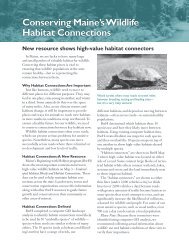
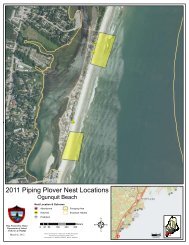
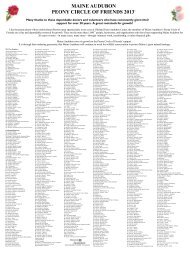
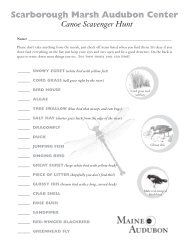

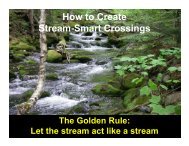
![2012 Loon Count Results [pdf] - Maine Audubon](https://img.yumpu.com/26228732/1/190x245/2012-loon-count-results-pdf-maine-audubon.jpg?quality=85)
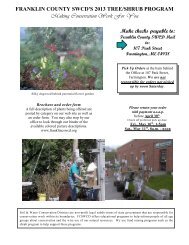
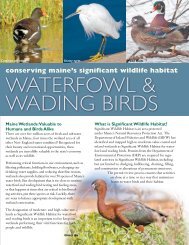
![Lake Fish of Maine (DIFW list) [pdf] - Maine Audubon](https://img.yumpu.com/23282964/1/190x245/lake-fish-of-maine-difw-list-pdf-maine-audubon.jpg?quality=85)
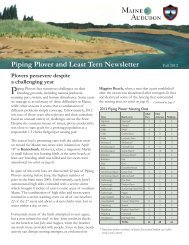

![The Maine Audubon Peony Circle of Friends 2012 [pdf]](https://img.yumpu.com/22707677/1/190x253/the-maine-audubon-peony-circle-of-friends-2012-pdf.jpg?quality=85)
